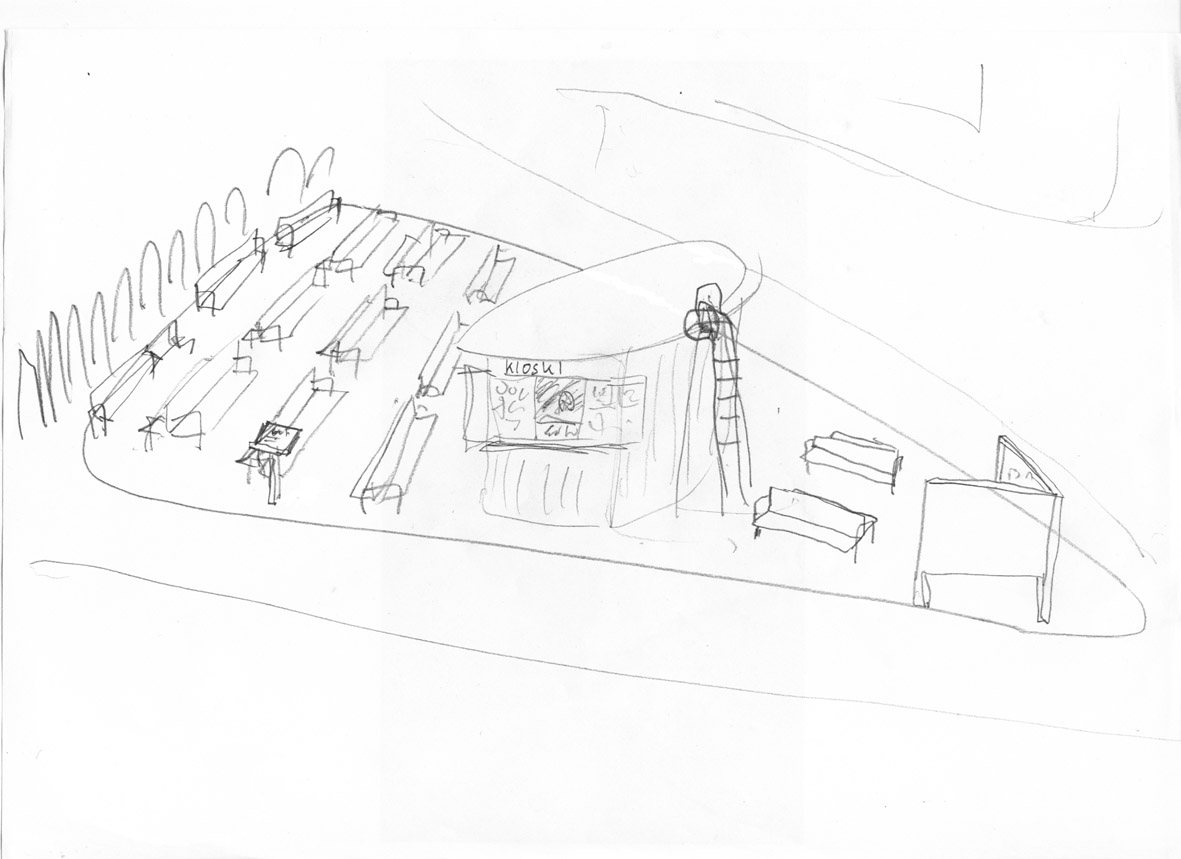Dear.
I do well. I am in Berlin now, work like hell on a symposium I am organizing and on the cataloge of the exhibition I curated last year. I work a bit too much, but it will be finished in a month. Than I have two exhibitions on my own and am happy to work on that.
I felt a bit strange in Rauma.
I appreciated the strolling through town, all the small sensations of a small town abroad. I was in a dream state with a strange mixture of anxiety: I didn't have the strength to give up some ideas and really do the others. But it was not easy also.
As an architect and urban planer I once a week offered guided tours to the entrances and traces of the Great Garden.
Later than a waiting area got installed.
A triangular piece of land at a cross road behind the former railway station, at the beginning of a worker's quarter, on the way from downtown to the beach. An abandoned kiosk we revived, and since then it still is a kiosk. The rumours, that the old licencee lived in the basement, could get approved. Next to it long rows of benches like in a bus or railway station we mounted.
Somehow I was happy, that it didn't really work with the Waiting Area of the Great Garden Project.
I liked the sign at the pedestrian walk, simple like a music stand for notes announcing it. I liked that triangular site, the kioski (and its mysterious wide-spread basements), where you could buy booze and cigarettes and newspaper and lemonade, with the wooden houses and concrete apartment buildings around, with the two big banal advertisement panels that formed the peak, corner of the site, pointing to town and painted in that skin-(more proper: panti hose-) to salmon-colour. I can't get away from hat colour and so I painted for long to get the deepness of skin to it, without loosing its artificialness. I loved that. Finnish trains have a colour for its curtains, that suit nicely.
Thus, the panels remained empty solely advertise themselves and the edge, they assign. On the backsides there was little information about the project.
Next to the kiosk I wanted to have the raised chair of the abandoned tennis court from the forest, but that didn't work out.
The Kiosk since then is at work, three laughing ladies run the place. It's sponsored by those, who gave the lemonade.
The project worked, not quite.

As I got tired of waiting, I started to build a paper balloon, from newspaper, big enough to carry me, so that I with big jumps, albatros-like, could take steps in trying to flee, to fly through the empty lanes of the one-storey wooden old town.
The old town had a sensation to me:
A one-storey high wild west town, ran over not by red Indians, but by tourists. I liked that the old town streets ended in washed concrete, super-markets and motorways.
I imagined myself roaming around the lanes with the balloon. An ugly one, looking more like a prolonged bag than a sphere. A balloon that made me hover, long jumps like on the moon, but not more. I had the paper together and the plans, easy. A desperate try. Not too desperate. I had no ill-insurance at that time so I skipped it.
I will do that somewhen.
Another sensation was the lace-making: I knew it before from nostalgic films and from the cheap version of it made from plastic. It had a grandma's garden touch. Here it was even more artificial. It was just in the core of tourism that I saw it. I imagined a mechanical piano, that was using the rolls of the lace cushion. And vice versa, using the music rolls for pitsi pattern. Both are one.
But I had no money for that.
The fascist water tower made some impression on me, but I did not know what to do with it. Now I would do a film within and under. These columns without an end. The nuclear power station in the distance seen through the binocular. A watchtower with the sweet and ugly art café on top. I wonder what kind of uniform the one eye wears.
The forest surrounding with this huge radio antennas: A giant Walter de Maria lightning field.
All the rest is memories for a picture book, the midsummer blue, the asphalt of the new harbor poured as new borders, the karaoke, the pool in the forest, and the tennis even more hidden.
more about the project at Rauma Art Museum
